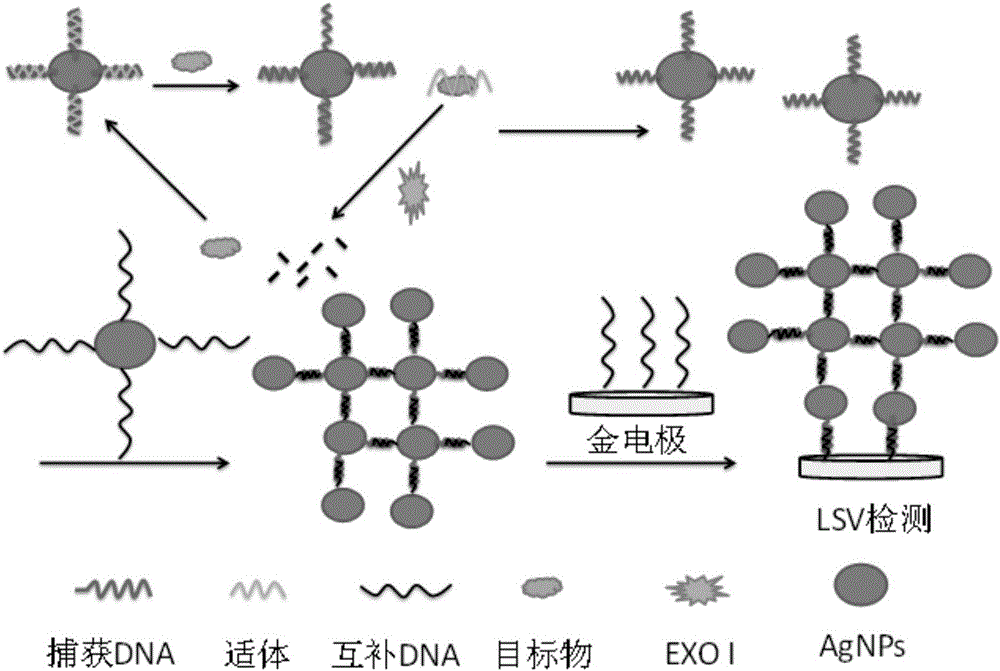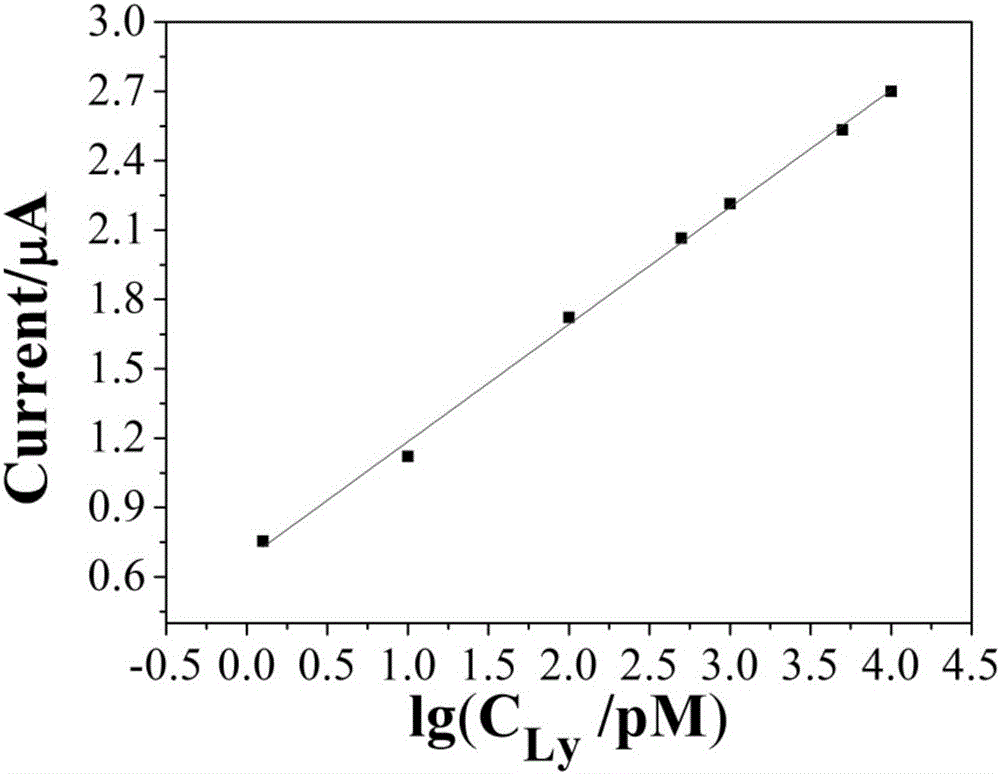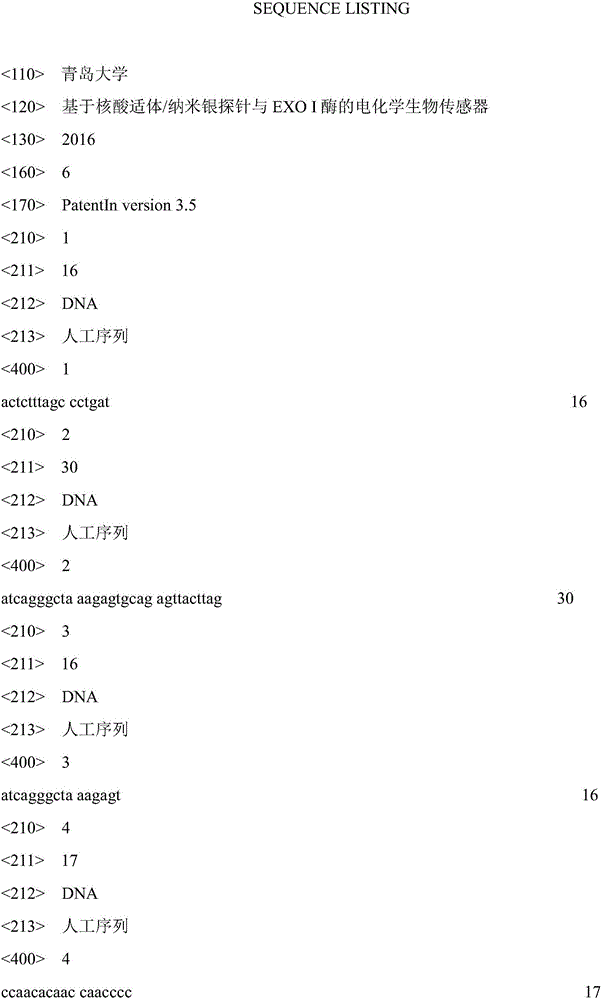Electrochemical biosensor based on aptamer/nano-silver probes and EXO I enzyme
一种生物传感器、核酸适体的技术,应用在电化学检测领域,能够解决稳定性差、免标记型电化学生物传感器使用范围限制、背底信号大等问题
- Summary
- Abstract
- Description
- Claims
- Application Information
AI Technical Summary
Problems solved by technology
Method used
Image
Examples
Embodiment 1
[0056] A preparation method for an electrochemical biosensor for detecting lysozyme, such as figure 1 shown, including the following steps:
[0057] (1) Nano silver preparation. In an ice-water bath, add 100ml of 0.003M sodium borohydride into a 250ml three-neck round bottom flask, seal the left and right openings, and stir vigorously. Slowly add 50mL of 0.002M silver nitrate to sodium borohydride drop by drop with a pipette gun, and wait for 2 minutes for each addition of 10ml. After the silver nitrate is completely added, continue to stir vigorously for 5 minutes. Move the round bottom flask into a boiling water bath, heat for 3 to 5 minutes, and immediately add 10ml of 0.003M sodium borohydride solution rapidly. The flask was removed from the hot water bath and continued to cool to room temperature with vigorous stirring. Transfer the prepared nano-silver colloid into a brown bottle soaked with aqua regia, and store it in the dark at 4°C.
[0058] (2) Capture probe prep...
Embodiment 2
[0068](1) Capture probe preparation. Take 10 μL of capture probe DNA (5'-A CTC TTT AGC CCT GAT-C6-SH-3', whose sequence is shown in SEQ ID NO: 1) and add 2 μL of 0.01M TCEP to the capture probe DNA in a 2 mL centrifuge tube (0.01MPB, 0.1M NaCl) solution was allowed to stand for 1 hour to open the disulfide bonds. Then add 10 μL of lysozyme aptamer (5'-ATC AGGGCT AAA GAG TGC AGA GTT ACT TAG-3', whose sequence is shown in SEQ ID NO: 2) and react in a water bath at 37°C for 1.5 hours to form double strands. Take a 3mL glass reaction bottle, add 1ml of nano-silver colloid to it, then add double-stranded DNA to it, seal it away from light and stir slowly for 5-6 hours, take out the magnet and react at 5°C for 13 hours. After 13 hours, add 122 μL of 0.1 M PBS buffer solution to the reaction flask to adjust the pH, and stir slowly. Add 21 μL of 2M NaCl solution at a rate of 1 μL each time, seal and keep away from light and stir slowly for 3 hours, seal and keep away from light over...
Embodiment 3
[0075] Adopt the electrochemical biosensor prepared in embodiment 1 to measure the application method of lysozyme concentration, comprise the following steps:
[0076] (1) Electrochemical detection. After taking out the electrodes obtained in Example 1, rinse them with 0.01M PB for 2-3 times, immerse the electrodes in the detection solution of 0.2M PBS, form a three-electrode system with a calomel reference electrode and a platinum wire reference electrode for LSV detection .
[0077] (2) Draw the standard curve. The logarithm of the LSV peak current after the lysozyme identification with the standard concentration is done to the logarithm of the lysozyme concentration to obtain the standard curve of the method, such as figure 2 As shown, the linear regression equation is I=0.5068lgC+0.67798, R 2 =0.997, linear range: 1.5pM-10nM, detection limit: 290fM (S / N=3).
[0078] (3) Actual sample testing. The actual sample was taken and operated according to the method in Example...
PUM
 Login to View More
Login to View More Abstract
Description
Claims
Application Information
 Login to View More
Login to View More - R&D Engineer
- R&D Manager
- IP Professional
- Industry Leading Data Capabilities
- Powerful AI technology
- Patent DNA Extraction
Browse by: Latest US Patents, China's latest patents, Technical Efficacy Thesaurus, Application Domain, Technology Topic, Popular Technical Reports.
© 2024 PatSnap. All rights reserved.Legal|Privacy policy|Modern Slavery Act Transparency Statement|Sitemap|About US| Contact US: help@patsnap.com










